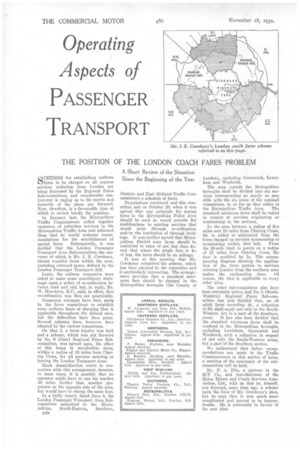Operating Aspects of PASSENGER TRANSPORT
Page 74

If you've noticed an error in this article please click here to report it so we can fix it.
THE POSITION OF THE LONDON COACH FARES PROBLEM
A Short Review of the Situation Since the Beginning of the Year
OCHEMES for establishing uniform bDfares to be charged on all express services radiating from London are being discussed by the Regional Fares Sub-committees, and considerable controversy is raging as to the merits and demerits of the plans nut forward. Now, therefore, is a favourable time at which to review briefly the position.
In January last, the Metropolitan Traffic Commissioner called together operators of suburban services in the Metropolitan Traffic Area and informed them that he would welcome recommendations for the establishment of agreed fares. Subsequently, it was decided that the London Passenger Transport Area Sub-committee, the convener of which is Mr. J. E. Cowderoy, should consider fares within the area, including outward spurs, defined by the London Passenger Transport Bill.
Later, the railway companies were asked to make some conciliatory statement upon a policy of co-ordination between road and rail, but, in reply, Mr. W. Monekton, K.C., said, in effect, that co-ordination was then not practicable.
Numerous attempts have been made by the fares committees to establish some uniform basis of charging that is applicable throughout the defined area, but the difficulties have been great. Several schemes have, however, been adopted by the various committees.
On May 2, a fares inquiry was held and a scheme, which was put forward by No. 6 (East) Regional Fares Subcommittee, was agreed upon, the effect of this being to standardize fares, within a radius of 15 miles from Charing Cross, for all services entering or leaving the London Transport Area.
Much dissatisfaction exists in connection with this arrangement, because, in some cases, it is possible that an operator might have to run his coaches BO miles farther than another proprietor on the opposite side of the area, but would have to charge the same fare.
• In a bulky report, dated June 8, the London Passenger Transport Area Subcommittee submitted to the Metropolitan, South-Eastern, Southern, n4S Eastern and East Midland Traffic Commissioners a schedule of fares.
Negotiations continued and this committee met on October 20, when it was agreed that any principle for zoning fares in the Metropolitan Police Area should be such as would provide for modifications to existing services that Would arise through co-ordination and/or the institution of through bookings. It was further agreed that Metropolitan district zone fares should be restricted to rates of not less than 4s., and that where the single fare is 4s. or lss, the rates should be on mileage.
It was at this meeting that Mr. Cowderoy submitted his scheme, which has been adopted by the committee and is particularly interesting. The arrange-. ment provides that a standard minimum fare should be charged in the Metropolitan boroughs (the County of London), excluding Greenwich, Lewisham and Woolwich.
The area outside the Metropolitan boroughs shall be divided into six sections corresponding as nearly as possible with the six areas of the regional committees, in so far as they relate to the Metropolitan Traffic Area. The standard minimum fares shall be varied in respect of services originating or terminating in the sections.
In the area between a radius of five miles and 10 miles from Charing Cross, 6d. is added or subtracted from the fares charged on services commencing or
terminating within that belt. From the 10-mile limit to points on a radius of 15 miles from Charing Cross, The fare is modified by is. The accompanying diagram showing the application of the fares system to services entering London from the northern area makes the explanation clear. Of course, the idea is applicable to every other area.
The other sub-committees also have been extremely active, and No. :3 (SouthWestern) Regional Fares Sub-committee has just decided that, on nil adult fares exceeding 4s., a reduction of 6d. shall apply not only to the SouthWestern, but to a part of the Southern, areas. It has also been decided that 'the standard minimum fares shall he confined to the Metropolitan boroughs, excluding Lewisham, Greenwich and Woolwich, with a reduction in respect of not only the South-Western areas, but a part of the Southern section.
We understand that before recommendatioes are made to the Traffic Commissioners in this matter of fares, a meeting of the conveners of the subcommittees will be held.
Mr. F. A: Elie, a partner in the M.T. Co., and vice-chairman of the Motor Hirers and Coach Services Association, Ltd., tells us that he, himself, put forward, some time ago, a scheme upon the lines of Mr. Cowderoy's plan, but he says that it was much more complicated and proved to be impracticable. He is personally in favour of the new plan.




















































































































